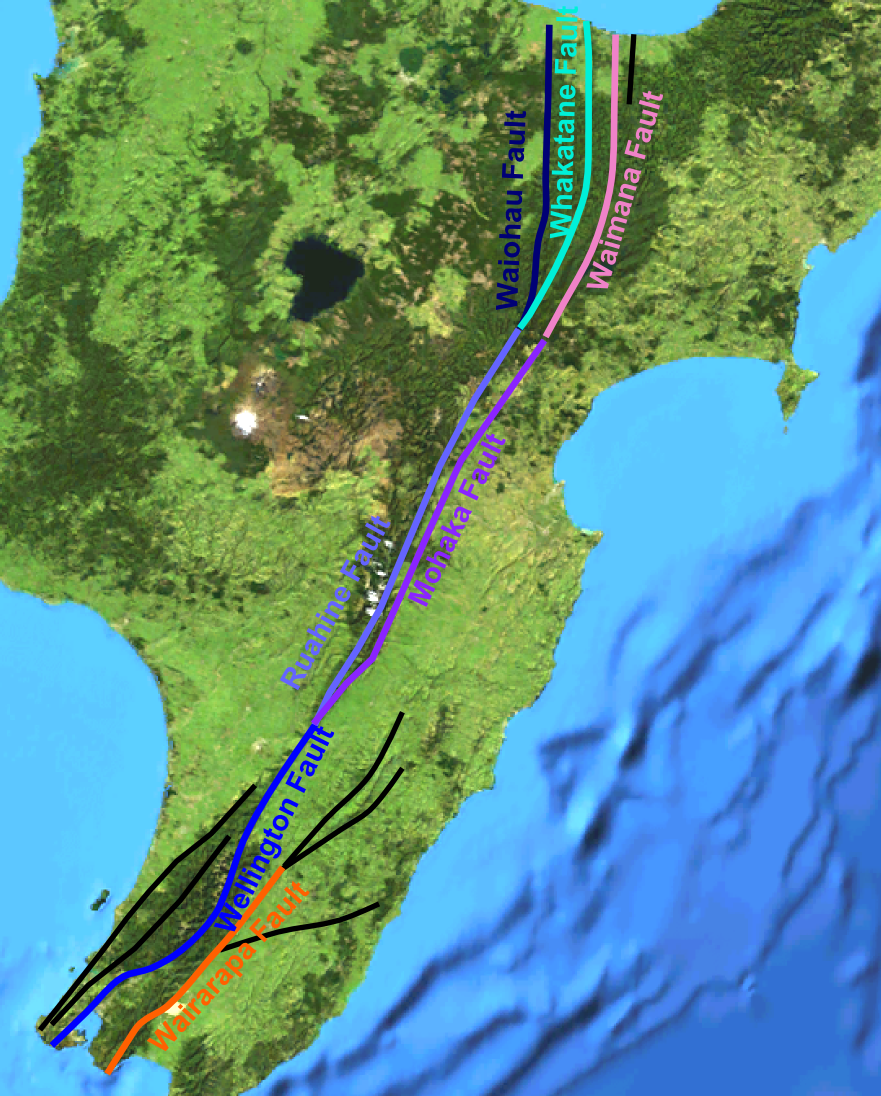Wellington Fault on:
[Wikipedia]
[Google]
[Amazon]

 The Wellington Fault is an active seismic fault in the southern part of the North Island of
The Wellington Fault is an active seismic fault in the southern part of the North Island of
Wellington Fault
at GNS Science
''Wellington Fault''
– video by GNS Science (10 min.) * {{Seismic faults of New Zealand Seismic faults of New Zealand Wellington Region Hawke's Bay Region Strike-slip faults

New Zealand
New Zealand ( mi, Aotearoa ) is an island country in the southwestern Pacific Ocean. It consists of two main landmasses—the North Island () and the South Island ()—and over 700 smaller islands. It is the sixth-largest island count ...
. It is a dextral (right-lateral) strike-slip fault with variable amounts of vertical movement causing uplift to the northwest, as expressed by a series of ranges. It forms part of the North Island Fault System, which accommodates the transfer of displacement along the oblique convergent boundary between the Indo-Australian Plate and Pacific Plate.
Geometry
The Wellington Fault consists of three main sections.Wellington-Hutt Valley section
This 75 km long curved fault segment is mapped on the floor of the Cook Strait before crossing the Wellington peninsula through Long Gully and along the northwestern edge of Wellington Harbour, past Lower Hutt terminating near Kaitoke. This segment has had a lateral slip-rate of 6.0–7.6 mm per year for at least the last 140,000 years, from the progressive offset of datedriver terrace
Fluvial terraces are elongated terraces that flank the sides of floodplains and fluvial valleys all over the world. They consist of a relatively level strip of land, called a "tread", separated from either an adjacent floodplain, other fluvial te ...
s. The most recent rupture event along this section is constrained to 150–450 yrs BP. This section is interpreted to give rise to characteristic earthquake
Earthquake prediction is a branch of the science of seismology concerned with the specification of the time, location, and magnitude of future earthquakes within stated limits, and particularly "the determination of parameters for the ''next'' ...
s involving rupture of the entire fault segment, with a single-event displacement of 3.8–4.6 m. The recurrence interval is 500–770 years. The Kaitoke basin is a small pull-apart basin formed at the 2 km lateral offset between this segment and the Tararua segment, near Kaitoke.
It is possible that the Māori legend of the formation of Whanganui-a-Tara (Wellington Harbour) derives from an oral record of an early quake along this fault.
Tararua section
The 53 km long arcuate Tararua segment starts just north of Kaitoke along the eastern side of theTararua Range
The Tararua Range, often referred to as the Tararua Ranges or Tararua, is one of several mountain ranges in the North Island of New Zealand.
The Tararua Range runs northeast–southwest for from near Palmerston North to the upper reaches of ...
. It terminates near Putara. It consists of two active fault strands, the southeasterly of which carries most of the displacement, as shown by offset drainage patterns. The strike of this section changes from 041° in the south to 020° in the north. The dextral slip rate for this section is 4.9–7.6 mm/yr, with a single-event displacement of 3.5–5.5 m and a recurrence interval of 500–1120 years.
Pahiatua section
This 42 km long segment runs from near Putara in the south to near Woodville in the north, where the fault branches into the Ruahine and Mohaka Faults. This segment is relatively linear with a strike of 033°. The dextral slip rate for this section is 4.9–6.2 mm/yr, with a single-event displacement of 4.5±1 m and a recurrence interval of 560–1120 years.Seismic hazard
Although no historic earthquake has been recorded for this fault, the potential impact of rupture along the Wellington-Hutt Valley section on the Wellington area makes it one of the greatest natural hazards in New Zealand. The Wellington Fault is also capable of producing earthquakes of up to magnitude-8. While a major rupture on the Wellington Fault can be expected anytime in the next 500 years, a significant earthquake on other faults in the Wellington area have a shorter 150 year return time.See also
*Geology of New Zealand
The geology of New Zealand is noted for its volcanic activity, earthquakes and geothermal areas because of its position on the boundary of the Australian Plate and Pacific Plates. New Zealand is part of Zealandia, a microcontinent nearly half t ...
* Geology of the Wellington Region
* North Island Fault System
*Wairarapa Fault
The Wairarapa Fault is an active seismic fault in the southern part of the North Island of New Zealand. It is a dextral (right lateral) strike-slip fault with a component of uplift to the northwest as expressed by the Rimutaka Range. It forms pa ...
Notes
References
*Richard W. Heine: ''A New Interpretation of the Geomorphology of Wellington''. In ''Journal of the Royal Society of New Zealand'', Juni 1982, p. 189–205 ()External links
Wellington Fault
at GNS Science
''Wellington Fault''
– video by GNS Science (10 min.) * {{Seismic faults of New Zealand Seismic faults of New Zealand Wellington Region Hawke's Bay Region Strike-slip faults